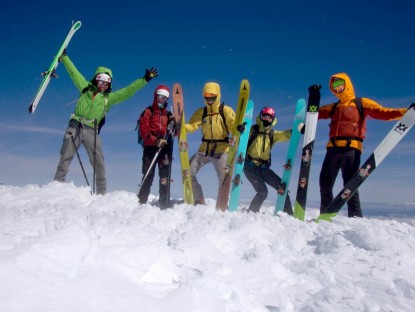G3 Synapse Carbon 109 Review
Our Verdict
Our Analysis and Test Results
The New G3 Synapse Carbon 109
Though we were unable to notice any changes other than a minor update to the graphics (since we last reviewed this pair of skis), we have contacted G3 for additional information.
Below is a side-by-side comparison, with the 16-17 model shown on the left and the 15-16 model pictured on the right.The G3 Synapse Carbon 109 is one of only two fully reverse cambered skis in our review.
Weight
G3 has revamped their entire ski line, and weight has dropped in all its models. The Synapse Carbon 109 hits the sweet spot, with an amazing weight-to-surface-area ratio. It is the widest ski in our test, but not the heaviest. As compared to the baseline K2 Wayback 96 for instance, the G3 is just a little heavier. However, if we correct for surface area, as we did in our weight/surface area calculations, the G3 weighs less per square centimeter of base. In fact, three of the skis we tested, including the Editors' Choice Volkl V-Werks BMT 94, have higher weight/surface area ratios.
Stability at Speed
In soft snow, we could let these run fast. However, the prominent reverse camber makes them wander and wobble at speed when it's harder. Our stability ratings have to reflect this.
Firm Snow Performance
Generally, we avoid attributing any sort of performance quality to single ski design attribute. How a ski rides is a function of so many variables that to single one out is short-sighted and only tells part of the story. However, with the G3 Carbon Convert, it sure seems that the full reverse camber design leaves the hard snow performance somewhat lacking. We never felt out of control, but we did find that we couldn't really stomp down on the hard and expect a consistent, immediate response. The edges just don't seem to bite as well as something narrower like the K2 Wayback or stiffer like the Fischer Hannibal 94. Interestingly, our Editors' Choice pick is also fully reverse cambered. The Volkl BMT 94, with a far narrower profile and a healthy dose of carbon, certainly grabs better on firm snow than the Synapse. The fact that the BMT does so well on firm snow points out the inherent limitations of attributing performance to single design characteristics. Rockered skis can ski firm snow just fine, as long as everything else is in order.
Powder Performance
The skis we tested were virtually indistinguishable in perfect powder. Modern skis of all shapes, sizes, and materials are fun in powder. The G3 was no exception. We do wish we could let them run even faster when it was soft and good, but we never quite found the confidence in their high speed tracking to really let them go. The Top Pick DPS Wailer 99 does great in perfect powder snow, and is considerably lighter for the uphill.
Crud/Poor Snow Performance
It was in this category that the G3 Synapse really surprised us. On a wicked windy day, deep in the Wind River wilderness of Wyoming, carrying a full pack of ski mountaineering and overnight gear, our lead tester skied a pitch of wind-affected snow linking fun, bouncy turns on the Synapse. His partners, accomplished and athletic skiers on different equipment, charged in after his lead, and promptly got schooled in the breakable, variable conditions. The snow was difficult, but the Synapse skis virtually disguised all difficulty. No skis in our review performed as well as the Synapse on tricky snow. We had okay luck with the Volkl, as well as with our Top Pick DPS Wailer 99 Tour, but they Synapse outperformed them all. If you are looking for a true bad snow basher, check out any of what we tested in our all mountain ski review. It is in poor snow (and at speed on any sort of snow), that the greater mass of on-resort skis lends significant performance gains. Many strong backcountry skiers choose to tour with all-mountain skis for that reason.
Best Applications
With their good powder skiing performance and amazing bad snow acumen, we recommend these for soft snow, cold-climate backcountry touring.
Value
These are not inexpensive skis. Additionally, the lightweight construction is likely to break down more rapidly than heavier models. In fact, our first pair of tested Synapse Carbon skis broke in routine use. G3 readily replaced them, and the replacements were just fine.
Conclusion
One tester called these, pre-failure, his favorite skis ever. His initial impression was of an easy-turning, energy-filled fun stick. Aside from some chatter in the steeps, we found the lightweight construction and solid soft snow performance to be adequate and enjoyable. We hope that G3 can limit the construction issues and keep making this fun, soft snow specialist.













